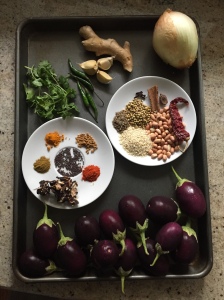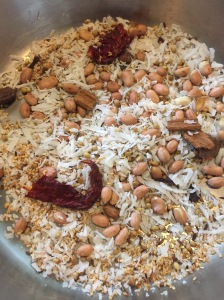 Bagare Baingan is a signature dish from the south Indian city of Hyderabad, in the state of Andhra Pradesh. ‘Bagare’ means tempered or roasted, and ‘Baingan’ means eggplant. Put together, the two words are used to describe a dish where tender eggplants are simmered in a sauce made with roasted peanuts, sesame seeds, dry coconut, onions and other whole spices. This dish is famously born in the royal kitchens of the nawabs who ruled the province of Hyderabad on behalf of the emperors of the Mughal empire.
Bagare Baingan is a signature dish from the south Indian city of Hyderabad, in the state of Andhra Pradesh. ‘Bagare’ means tempered or roasted, and ‘Baingan’ means eggplant. Put together, the two words are used to describe a dish where tender eggplants are simmered in a sauce made with roasted peanuts, sesame seeds, dry coconut, onions and other whole spices. This dish is famously born in the royal kitchens of the nawabs who ruled the province of Hyderabad on behalf of the emperors of the Mughal empire.
Bagare Baingan is a labor of love. The nuts, seeds, spices are roasted until they release their aromatic oils and then ground into a fine paste. The onions are roasted over an open fire until they are charred on the outside and tender inside. Along with a ginger garlic paste and tamarind juice, these ingredients are the basis for the full bodied, tangy and spicy sauce. Jaggery or palm sugar is an optional addition for those who enjoy a bit of sweetness to round off the flavors. Meanwhile the eggplants are given a good wash and then thoroughly dried off. The stalk is trimmed to remove any dry ends, and starting at the base of the eggplant, cut down almost until the stalk end but not completely through. Then another cut at a 90-degree angle to the first cut, resulting in an eggplant that is divided into four sections that are sturdily held together by the stalk end. Be careful not to hurt yourself when you get to this task. The eggplant is then deep fried until al dente. To complete the cooking the eggplants are introduced into the sauce and simmered. The idea of the crisscross cut of the eggplant is to allow room for movement of the sauce within the inner depths of the eggplant. This serves the double purpose of flavoring the insides and also cooking them. It is also easy to plate an eggplant cut into sections still held together by the stalk.
I briefly lived in Hyderabad, and remember attending weddings and other celebrations where bagare baingan was a must on the menu and served with pride. The traditional method of making this dish involves the use of a lot of oil. So much that the oil is supposed to float atop the eggplants. The use of lots of oil was excusable since this is a dish that you did not eat everyday and was meant only for special occasions. Thanks to a few short cuts I make this dish more often and so have cut down on the amount of oil I use.
 My shortcuts involve the use of a heavy bottomed pan to sear and pan fry the eggplants in a small amount of oil rather than deep fry them. The traditional recipe calls for making an onion paste and caramelizing it in a lot of oil, then adding the ginger garlic paste and the paste made with the roasted seeds, nuts and spices. Tamarind is soaked in water until soft and the tamarind water extracted and added into the sauce. I’ve cut down on a lot of these steps. I blend the roasted nuts, seeds, spices, onions, ginger, garlic and tamarind in one shot to make the master paste for the sauce. I am careful to discard any tamarind seeds before I add the tamarind into the blender. The blended master paste is cooked in a smaller amount of oil until a caramelization sets in and the flavors become synchronous.
My shortcuts involve the use of a heavy bottomed pan to sear and pan fry the eggplants in a small amount of oil rather than deep fry them. The traditional recipe calls for making an onion paste and caramelizing it in a lot of oil, then adding the ginger garlic paste and the paste made with the roasted seeds, nuts and spices. Tamarind is soaked in water until soft and the tamarind water extracted and added into the sauce. I’ve cut down on a lot of these steps. I blend the roasted nuts, seeds, spices, onions, ginger, garlic and tamarind in one shot to make the master paste for the sauce. I am careful to discard any tamarind seeds before I add the tamarind into the blender. The blended master paste is cooked in a smaller amount of oil until a caramelization sets in and the flavors become synchronous.
With regard to roasting the onion, if you have a gas stove, the job is easy. Just place the entire onion over the gas and slowly char it on a gentle flame. Use tongs to turn it every now and then so that the charring is even. Be careful and don’t walk away from the onion. Sensitive smoke alarms may go off, so its best if you ventilate your kitchen while charring the onion. If you don’t have a gas stove, then peel and cut the onion into large chunks. Preheat a cast iron pan and roast the onion chunks in the preheated pan until they are charred and smoky. You can also achieve this same effect by roasting the onion over a barbecue. Once you have sufficiently charred the onion, use your tongs to transfer the onion to a plate. Let cool. Once cooled, discard the blackened parts of the skin, remove the top and bottom ends, and you are ready to use this onion in the dish.
A final note about selecting eggplants for this dish. There are several varieties available in the super market today – different shapes and sizes; but the kind that is best suited for this dish is the small baby eggplants that you see in the picture above. You want to pick eggplants that are small and not overgrown, have a bright green stalk, and a nice smooth purple skin.
Serves 4 Cooking time: 60 - 75 mins Ingredients: 6 tbsp. vegetable oil 12 baby eggplants, washed, dried and cut as described in the notes above 2-4 green chillies or thai peppers some fresh cilantro stems For the spice paste: 2 tbsp. raw peanuts 1 tbsp sesame seeds 2 tsp. coriander seeds 1/2 tsp cumin seeds 2" piece cinnamon bark, smaller piece if your cinnamon is too wide and thick 4 cloves 1 black cardamom 1 dry red chilli 1/4 cup unsweetened dry coconut 1 medium sized onion, fire roasted, see notes above 3-4 large garlic cloves 2" piece ginger 1 tbsp tamarind, cleaned of any seeds 1/2 tsp red chilli powder 1/2 tsp turmeric powder 1/2 tsp garam masala powder 1/2 cup water For tempering: 1/2 tsp black mustard seeds 1/4 tsp fenugreek seeds 12 curry leaves Method: Roast on low heat the raw peanuts, sesame seeds, coriander seeds, cumin seeds, cinnamon bark, cloves, black cardamom, dry red chilli and unsweetened dry coconut in a pan until the sesame seeds start popping. Take off the heat and let the mixture cool. Once it is cool, prepare a smooth paste with these roasted items, the fire roasted onion, garlic, ginger, tamarind, chilli powder, turmeric powder, garam masala powder and water. Set aside. Preheat a dutch oven or cast iron pan or non-stick pan on medium heat. Add 3 tbsps. cooking oil to the pan, and follow with the prepared eggplants. Cook on medium heat, turning often with tongs until the eggplants are evenly seared and the insides look almost done. Remove from pan and set aside. Add 3 more tbsps oil to the pan, and put in the mustard, fenugreek, green chillies and curry leaves. When the mustard starts popping, introduce the masala paste to the pan. Stir constantly so as to avoid burning the sauce. Add about a 1/2 tsp of jaggery if you are using it. If you don't have jaggery on hand but still enjoy a bit of sweetness, go ahead and add 1/2 tsp of sugar. Let the sauce cook until it has thickened a bit and the oil starts separating from the masala. Now is the time to add the eggplants, along with 1/2 cup of water. Simmer covered, until the eggplants are cooked all the way through, about 10 more minutes. Garnish with chopped cilantro and serve with hot phulkas or jeera rice.






Great recipe !
LikeLiked by 1 person